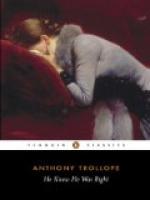Miss Stanbury belonged to the county set, but she lived in a large brick house, standing in the Close, almost behind the Cathedral. Indeed it was so close to the eastern end of the edifice that a carriage could not be brought quite up to her door. It was a large brick house, very old, with a door in the middle, and five steps ascending to it between high iron rails. On each side of the door there were two windows on the ground floor, and above that there were three tiers of five windows each, and the house was double throughout, having as many windows looking out behind into a gloomy courtyard. But the glory of the house consisted in this, that there was a garden attached to it, a garden with very high walls, over which the boughs of trees might be seen, giving to the otherwise gloomy abode a touch of freshness in the summer, and a look of space in the winter, which no doubt added something to the reputation even of Miss Stanbury. The fact for it was a fact that there was no gloomier or less attractive spot in the whole city than Miss Stanbury’s garden, when seen inside, did not militate against this advantage. There were but half-a-dozen trees, and a few square yards of grass that was never green, and a damp ungravelled path on which no one ever walked. Seen from the inside the garden was not much; but, from the outside, it gave a distinct character to the house, and produced an unexpressed acknowledgment that the owner of it ought to belong to the county set.
The house and all that was in it belonged to Miss Stanbury herself, as did also many other houses in the neighbourhood. She was the owner of the ‘Cock and Bottle,’ a very decent second class inn on the other side of the Close, an inn supposed to have clerical tendencies, which made it quite suitable for a close. The choristers took their beer there, and the landlord was a retired verger. Nearly the whole of one side of a dark passage leading out




